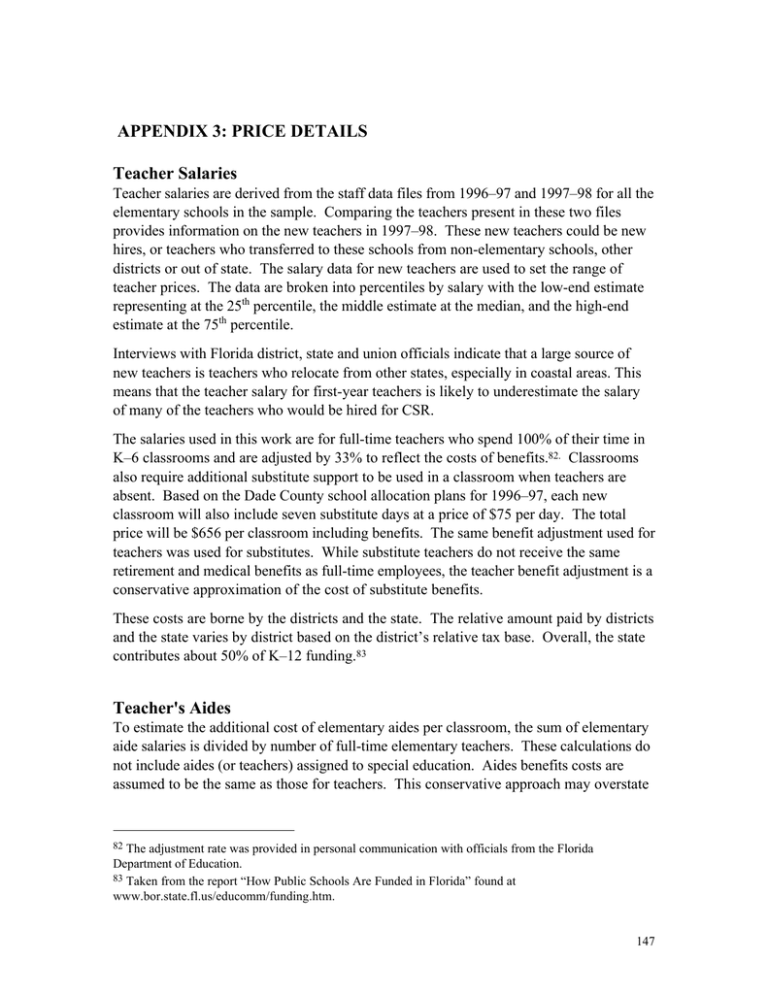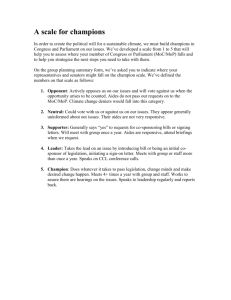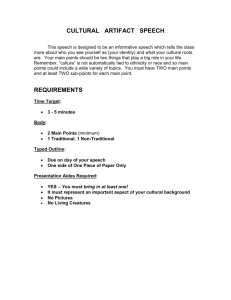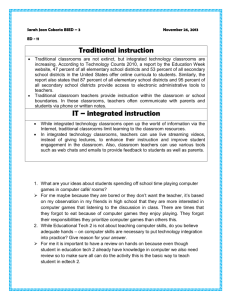APPENDIX 3: PRICE DETAILS Teacher Salaries
advertisement

APPENDIX 3: PRICE DETAILS Teacher Salaries Teacher salaries are derived from the staff data files from 1996–97 and 1997–98 for all the elementary schools in the sample. Comparing the teachers present in these two files provides information on the new teachers in 1997–98. These new teachers could be new hires, or teachers who transferred to these schools from non-elementary schools, other districts or out of state. The salary data for new teachers are used to set the range of teacher prices. The data are broken into percentiles by salary with the low-end estimate representing at the 25th percentile, the middle estimate at the median, and the high-end estimate at the 75th percentile. Interviews with Florida district, state and union officials indicate that a large source of new teachers is teachers who relocate from other states, especially in coastal areas. This means that the teacher salary for first-year teachers is likely to underestimate the salary of many of the teachers who would be hired for CSR. The salaries used in this work are for full-time teachers who spend 100% of their time in K–6 classrooms and are adjusted by 33% to reflect the costs of benefits.82. Classrooms also require additional substitute support to be used in a classroom when teachers are absent. Based on the Dade County school allocation plans for 1996–97, each new classroom will also include seven substitute days at a price of $75 per day. The total price will be $656 per classroom including benefits. The same benefit adjustment used for teachers was used for substitutes. While substitute teachers do not receive the same retirement and medical benefits as full-time employees, the teacher benefit adjustment is a conservative approximation of the cost of substitute benefits. These costs are borne by the districts and the state. The relative amount paid by districts and the state varies by district based on the district’s relative tax base. Overall, the state contributes about 50% of K–12 funding.83 Teacher's Aides To estimate the additional cost of elementary aides per classroom, the sum of elementary aide salaries is divided by number of full-time elementary teachers. These calculations do not include aides (or teachers) assigned to special education. Aides benefits costs are assumed to be the same as those for teachers. This conservative approach may overstate 82 The adjustment rate was provided in personal communication with officials from the Florida Department of Education. 83 Taken from the report “How Public Schools Are Funded in Florida” found at www.bor.state.fl.us/educomm/funding.htm. 147 aides costs since aides may not receive the same benefit package as teachers, and some part-time or temporary aides may not qualify for benefits. The estimated price per classroom for aides’ salaries and benefits is provided in Table 1. Dade’s aide price level at $11,000 is almost double the next highest level of Wakulla, which is at $5,645. This is due to a higher intensity in the use of aides. In Dade, the ratio of aides to full-time teachers was .72, compared to Wakulla, which was .43, and the lowest ratio of .28 seen in both Santa Rosa and Alachua. The salary per aide reflects both pay rates and percent of time worked. The average salary is about $10,000, with most districts ranging form $9,000 to $13,000. Alachua had the lowest average salary per aide at $4,900. Thus Alachua’s very low expenditures on aides was due to both low intensity of usage and low aides’ salaries. TABLE 1: ESTIMATED PRICE OF AIDES PER ELEMENTARY CLASSROOM BY DISTRICT District Alachua Broward Dade Hillsborough Pinellas Santa Rosa Wakulla Aide Salary & Benefits per Classroom $ 1,791 $ 3,655 $ 11,069 $ 4,533 $ 5,015 $ 4,894 $ 5,645 Operations and Maintenance District-wide averages are provided on the basis of cost per square foot. A key issue is converting cost per square foot into cost per classroom. The minimum square footage for kindergarten and primary student stations is 36 with a recommended size of 38 square feet. The minimum space requirement was used for the allocation of non-traditional classroom space to classrooms. The recommended size is appropriate for new classrooms. The average number of student stations per new classroom constructed between 1989 and 1997 was 21. Based on 38 square feet per student station and 21 student stations per classroom, the average size of a new classroom is just under 800 square feet. Table 2 shows the average operations, maintenance and utility costs per square foot and estimated cost per classroom for school year 1997–98. Operations, maintenance and utilities costs vary by a factor of two between districts, with the lowest costs in Santa Rosa district at about $3,000 per classroom and the highest costs in Dade district at just under $6,400 per classroom. These costs will be applied to the cost estimates for new classrooms in each district. 148 TABLE 2: ESTIMATED AVERAGE OPERATIONS, MAINTENANCE AND UTILITIES COSTS FOR NEW CLASSROOMS, BY DISTRICT Average District Cost Operations, Maintenance & Utilities Cost Per Square Foot $ 4.50 $ 5.90 $ 7.97 $ 4.78 $ 4.77 $ 3.75 $ 4.83 School District Alachua Broward Dade Hillsborough Pinellas Santa Rosa Wakulla Estimated Cost per Classroom Per New Classroom $ 3,601 $ 4,722 $ 6,378 $ 3,824 $ 3,817 $ 2,997 $ 3,862 Relocatable Classrooms Estimates of the cost of a relocatable classroom have considerable variation, potentially because of the reporting on different combinations of resources necessary to use a portable classroom. A complete set of resources includes not only the classroom itself, but cement slab to place the classroom and utility hookups. The prices used here of $4,800 per year for leasing a relocatable, and $30,000 for purchasing a portable as shown in Table 484. This price does not include the cost of student furniture and equipment. Since the number of students does not change with CSR, schools can use the same desks and chairs for students in their new classroom. The new teacher would require some equipment. The cost of this equipment is estimated to be $1,200, which is double the average furniture and equipment cost for a new student station. TABLE 3: COST OF RELOCATABLE CLASSROOMS Lease Purchase Cost Estimate $4,800 $30,000 Teacher Furniture & Equipment $1,200 $1,200 Total $6,000 31,200 Purchased Classrooms The Florida State Department of Education provided information on the price of building new classrooms. As part of the state's capital funding program the state monitors the cost of building and furnishing schools. Table 4 shows the average cost per elementary classroom (teacher station), between 1989 through 1997 and the running averages at the 1997 real dollar level using the CPI-U for shelter. Adjusting to 1997 real dollars is 84 Both estimates are based on personal interviews with school district officials. Purchased relocatable classrooms are assumed to have a lifetime of 15 years. Each is adequate for a class of up to 25 children. 149 appropriate for the real dollar adjustment since the school year these estimates are being done for 1997–98 begins in that year. The cost per teacher station varies between years between $226,914 and 286,533. The weighted85 average cost over the nine year period was just over $250,000. Another issue is the cost for construction of a new school. The State provided information on the size of the 22 new elementary schools built in 1998. These schools varied in size from housing 275 students to 1,079 with an average of 831. The estimate of $9.9 million per school is in 1997 dollars of, and based on an nine year weighted average cost of $12,000 per student station and an average size of 831 student stations. Based on the enrollment patterns, it can be assumed each school serves K-5, with relatively equal numbers of students in each grade. This translates to space for about 140 students per grade. TABLE 4: CLASSROOM CONSTRUCTION COSTS Calendar Year Per Teacher Stations $1,088 $1,764 $1,380 $577 $882 $1,115 $1,035 $749 $1,154 1989 1990 1991 1992 1993 1994 1995 1996 1997 Total Cost Per Teacher Stations (1997 $) $244,351 $264,786 $251,500 $235,091 $226,914 $240,227 $249,394 $286,533 $246,960 Source: Office of the Deputy Commissioner for Planning, Budgeting and Management TABLE 5: AVERAGE COST OF A SCHOOL 5-Year 6-Year 7-Year 8-Year 9-Year Average Average Average Average Average Weighted Average of a School $248,372 $246,982 $247,887 $251,331 $250,551 Source: Office of the Deputy Commissioner for Planning, Budgeting and Management 85 Weighted by number of classrooms. 150




